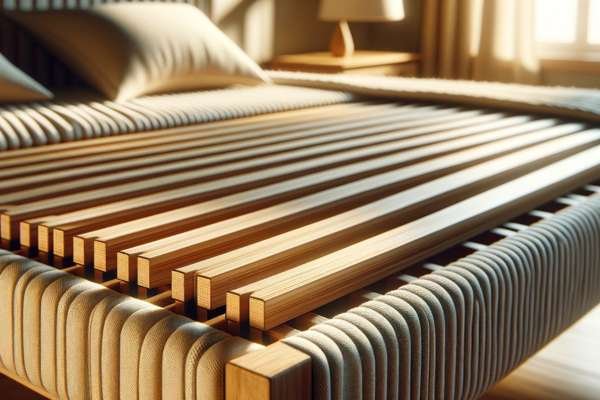Bed slats are integral structural elements of a bed frame, designed primarily to support your mattress. These slats, which can be made of materials like wood or metal, run horizontally across the frame to provide a stable foundation and prevent the mattress from sagging or losing shape over time. Understanding the importance of bed slats is key to enhancing your sleep experience. They not only help extend the life of your mattress by promoting even weight distribution but also ensure better air circulation, which is crucial for maintaining the mattress’s hygiene and comfort. Selecting the appropriate what are slats on a bed frame can make a significant difference in your overall sleep quality, making this knowledge essential for anyone seeking a restful night’s sleep.
Types of Bed Slats
When considering a new bed frame, understanding the different types of slats—solid, sprung, and adjustable—is essential. Solid slats provide a firm, stable foundation, ideal for those who prefer a harder sleeping surface. Sprung slats, on the other hand, offer more flexibility, enhancing comfort by adjusting to your body’s weight and movement. Adjustable slats take customization further, allowing you to modify the firmness under specific parts of your body, tailoring support to your personal needs. Each type of slat plays a crucial role in the overall comfort and support of your bed, influencing both sleep quality and the longevity of your mattress. Choosing the right type of slats can significantly enhance your sleeping experience.
Materials Used for Bed Slats
When considering what slats on a bed frame are made from, the three primary materials are wood, metal, and composite materials. Wooden slats are popular for their natural flexibility and durability, often made from sturdy woods like pine or oak. Metal slats provide exceptional strength and support, making them ideal for heavier mattresses. Composite materials, such as engineered woods or plastics, offer a budget-friendly option that combines the benefits of wood and metal, ensuring both support and cost-effectiveness. Each material type plays a crucial role in the overall functionality and longevity of a bed frame, catering to various preferences and needs.
Function of Bed Slats

Bed slats are essential components in any bed frame, designed to provide robust support for your mattress. By evenly distributing weight, these slats prevent sagging and help maintain the structural integrity of the mattress, thereby extending its lifespan. Moreover, the firm support offered by slats contributes significantly to sleep quality. Proper alignment and support can reduce back pain and improve posture during sleep. This makes choosing the right bed slats a critical decision for anyone looking to enhance their sleep experience and ensure their mattress lasts for years to come.
Advantages of Bed Slats
Bed slats are an essential component of a bed frame, offering several advantages that enhance both the functionality and comfort of your sleeping arrangement. Firstly, bed slats are highly affordable, making them a cost-effective alternative to more expensive foundations like box springs. Their versatility is another significant benefit, as they are compatible with various types of mattresses and can be adapted to different bed frames, adding to their universal appeal. Moreover, slats provide excellent ventilation. This feature is crucial as it allows air to circulate freely beneath the mattress, reducing moisture buildup and helping to maintain a cooler sleeping environment. Opting for bed slats can lead to a healthier sleep setup by preventing the growth of mold and mildew, thereby extending the lifespan of your mattress.
Disadvantages of Bed Slats
When considering bed slats in a bed frame, it’s important to be aware of their potential disadvantages. One common issue is sagging, which can occur over time if the slats are not sturdy enough to support the mattress. This can lead to discomfort and a less restful sleep. Additionally, bed slats can sometimes produce noise, especially if they are loose or made of lower-quality materials. This can become a nuisance, particularly for those who are light sleepers. Another concern is compatibility; not all mattresses are suited for slat systems. For example, some memory foam mattresses require a more solid foundation to prevent uneven wear. Choosing the right type of bed slats is crucial to avoid these issues and ensure a comfortable, quiet sleeping environment that is compatible with your mattress.
How to Choose the Right Bed Slats
Choosing the right bed slats can significantly enhance your sleep quality and bedroom aesthetics. First, consider the type of mattress you have. For instance, memory foam and latex mattresses often require closer-spaced slats to provide adequate support and prevent sagging. Next, think about your bedroom decor. The material and color of the slats should complement your existing furniture and overall room design. Finally, don’t overlook personal comfort preferences. The flexibility of sprung slats, for example, can offer a softer feel, which might be preferable for those seeking a less rigid bed foundation. By carefully considering these factors—mattress type, decor, and personal comfort—you can select the perfect slats for your bed frame, ensuring both a restful night’s sleep and a harmonious bedroom environment.
Installing and Maintaining Bed Slats
Installing and maintaining bed slats correctly is crucial for extending the life of your bed frame and ensuring optimal support for your mattress. Begin by ensuring that the slats are evenly spaced and securely attached to the frame, preventing any sagging or shifting. Regular maintenance includes checking for loose fittings and wear, and tightening any screws or fasteners as needed. It’s also advisable to occasionally rotate the slats if they are removable to promote even wear. Common issues such as creaking or breakage can often be remedied by adding extra support in the center of the frame or replacing damaged slats. By adhering to these simple upkeep tips, you’ll enhance your bed’s stability and comfort, making your sleep environment both supportive and durable.
Bed Slats vs. Box Springs
When choosing between bed slats and box springs, understanding their differences is crucial. Bed slats are wooden or metal bars laid across the bed frame, offering direct support to the mattress and promoting airflow, which can extend mattress life. Conversely, box springs are sturdy boxes with springs or a metal grid, providing a uniform base for spring mattresses. Slats are generally more affordable and easier to maintain, making them ideal for firmer support and modern aesthetics. Box springs, however, excel in shock absorption and overall durability, benefiting those who prefer a softer sleep surface. The choice between slats and box springs ultimately depends on your specific needs, such as mattress type, desired firmness level, and budget considerations. Opting for the right foundation can significantly enhance your sleep quality and bedroom functionality.
Conclusion
In conclusion, bed slats play a crucial role in providing support and durability to your sleeping arrangement. They offer direct mattress support, improve airflow, and can enhance the longevity of your mattress compared to other foundations. Choosing the right type of bed slats—whether solid, sprung, or adjustable—is essential for aligning with your sleep preferences and ensuring comfort. It’s important to explore various slat options to find one that best suits your mattress type and personal comfort needs. By selecting the appropriate bed slats, you not only optimize your bed’s functionality but also contribute positively to your overall sleep quality. Take the time to understand the different types of slats available and make an informed decision to elevate your sleeping experience.



